Clusters of Galaxies; Dark Matter
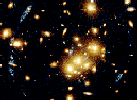
| H. E. Smith | Winter 2007 |

| Physics 7 - Lecture Summary #16 Clusters of Galaxies; Dark Matter |
 |

 |
Most galaxies are found in gravitationally-bound groups called "clusters". Clusters can be rich, with several thousand galaxies, or poor, with only 20 or 30 members. The Local Group, the cluster to which our own Milky Way galaxy belongs, is made up of about 30 galaxies. |
Clusters of galaxies are classified by their properties;richness (number of members),shape (spherical,flattened, or irregular),and galactic content (spiral-rich,spiral-poor, or elliptical-rich),for example. Some are strong radio sources, while others emit x-rays. The richest nearby cluster is Virgo, 60 million light years from the Milky Way. It contains about 2500 galaxies, mostly ellipticals.
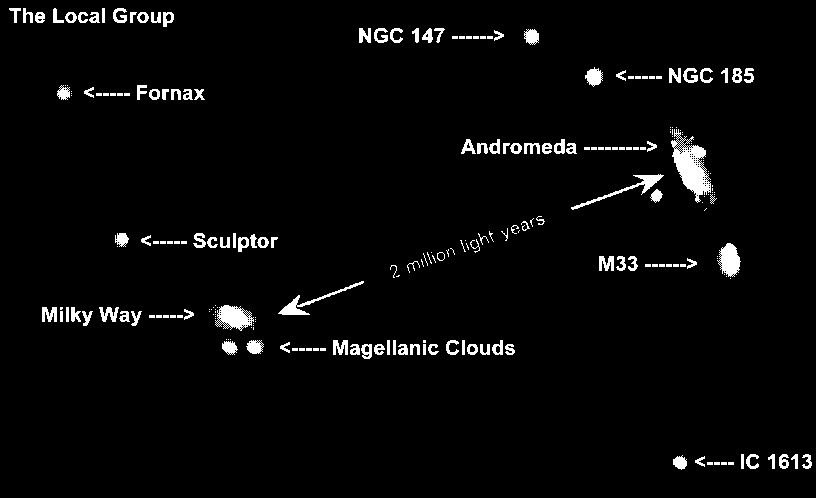
We reside in a small group called the
Local
Group which is dominated by
two giant spiral galaxies, Andromeda and our own Milky Way. In addition to
Messier 33, an intermediate mass Sc galaxy, there are 15 ellipticals and 13
irregular galaxies in the cluster, including the Magellanic Clouds, our
Galaxy's satellites, Messier 32 and NGC 205, satellites of Andromeda. The
group has a size of about 3 million l.y., and has a total mass
of 5 x 1012M
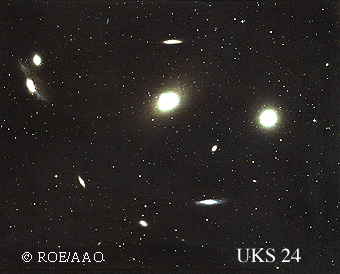
The Virgo Cluster, about 50 million l.y. away, is the nearest regular cluster of galaxies with several hundred members. Our Local Group is an outlying member of a "supercluster" of galaxies of which the Virgo Cluster is the dominant member.

The Hubble Space Telescope has provided the first opportunity to look back into the early universe at clusters. Billions of years ago, clusters contained many more spiral galaxies than they do today. They were probably disrupted over time by collisions and mergers within the clusters.
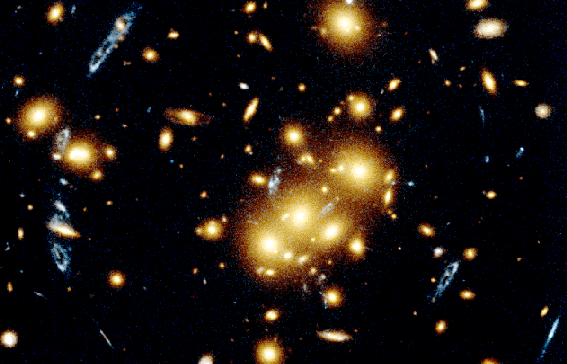
CL 0024+1654 is a large cluster of galaxies located 5 billion light-years from Earth. It is distinctive because of its richness (large number of member galaxies), and its magnificent gravitational lens. The blue loops in the foreground are lensed images of a spiral galaxy located behind the cluster.
Cluster Links
Einstein's General Theory of Relativity demonstrates that a large mass
can deform spacetime and bend the path of light. So, a very massive object,
such as a cluster of galaxies can act as a gravitational lens. When light
passes through the cluster from an object lying behind it, the light is
bent and focused to produce an image or images of the source. The image
may be magnified, distorted, or multiplied by the lens, depending upon
the position of the source with respect to the lesnsing mass.

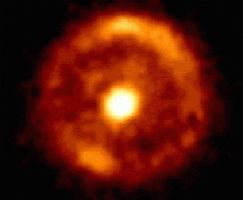 | The characteristics of the gravitationally lensed image depend upon the alignment of the observer, the lens and the background object. If the alignment is perfect, the resulting image is an Einstein Ring, shown to the left. This object, discovered by Radio Astronomers at England's Jodrell Bank Radio Observatory, then imaged in the near infrared with HST is probably a distant background galaxy lensed by an intermediate distance Elliptical galaxy, shown as the bright image at the center of the ring. The Ring is estimated to be about 10-20 times brighter than the background galaxy would appear without lensing. |
| If the alignment is not perfect, then multiple images are formed rather than a ring. The object to the right, called the Einstein Cross, shows four images of a distant quasar at a redshift, z=1.7, imaged by an intervening spiral galaxy with z=0.04. HST images have been processed to separate the galaxy and quasar images. |
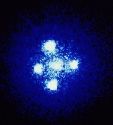 |
A gravitational lens is most effective if it is near midway between the observer and the distant object which is being lensed. The amplification, ratio of the lensed brightness of an object to its unlensed value, is larger if the line of sight passes very close to the lens. Lenses can amplify brightnesses by a few times, up to over a factor of 100 - this means that lenses offer the potential to "see" objects over 10 times further away.

We see three types of gravitational lenses:
Gravitational Lens Links
Observations of clusters and their galaxies, have uncovered one of the major mysteries in astronomy today. Clusters appear to be very stable entities- they contain mature galaxies with old stars, and seem to have been formed billions of years ago. But, when we calculate the amount of mass in a cluster using the orbital motions of its member galaxies, the result is too low for the cluster to be gravitationally bound. If the cluster contains only the mass we can observe, the gravitational force is insufficient to prevent the galaxies from "escaping".There must be more mass in the cluster than what we see.

The same problem arises when we look at the galaxies themselves. The rotation curve of a galaxy shows how the orbital velocities of the stars change with distance from the center. If the galaxy rotated as a solid disk, the velocity would increase linearly with distance. If most of the mass were concentrated at the the center, as in our solar system, the velocities of the stars would decrease with the square root of the distance. But, that is not what is observed. Far past the point where no mass is visible, the rotation curves are flat! This means that the mass is still increasing as we move outward, even though we can't see anything! One again we have to call upon "dark matter". The galaxy must extend much farther out than the luminous matter indicates. In fact, the calculations require that there be at least 10 times more mass than we can see! Calculations suggest that this dark matter is likely to be in an extensive halo of dark matter.
The nature of this dark matter or "missing mass" is unknown. There are theories ranging from the bizzare to the mundane, none of which successfully answer all of the questions.
The most attractive possibility is that the Dark Matter lies in some form of compact non-luminous object:
 the
number of stars increases dramatically as you go to stars of lower mass. Does
this trend continue as one goes below the cutoff for the ignition of nuclear
reactions? If so, failed stars, called Brown Dwarfs, might account for
a significant fraction of the Dark Matter. Brown Dwarfs are hard to spot
since they are cool and very low in luminosity. Recent infrared studies are
finding Brown Dwarfs, but not in sufficient numbers to make up the dark matter
needed in the Milky Way.
the
number of stars increases dramatically as you go to stars of lower mass. Does
this trend continue as one goes below the cutoff for the ignition of nuclear
reactions? If so, failed stars, called Brown Dwarfs, might account for
a significant fraction of the Dark Matter. Brown Dwarfs are hard to spot
since they are cool and very low in luminosity. Recent infrared studies are
finding Brown Dwarfs, but not in sufficient numbers to make up the dark matter
needed in the Milky Way.
Perhaps galaxies have large amounts of gas that has not been accounted for. But, cool atomic hydrogen would emit 21-cm radio waves, and these are not seen. Molecular hydrogen should be visible by its ultraviolet emission, but this is not observed. Hot gas emits x-rays, and several galaxy clusters are strong x-ray sources. The mass of intergalactic gas is calculated to be a considerable amount, perhaps greater than the amount in galaxies and stars, but is still too little to account for the cluster stability.
According to the most commonly accepted theory, Big Bang Nucleosynthesis, ordinary atomic nuclei formed as the Universe expanded and cooled. The theory allows detailed calculations of the amount of helium (4He) produced (also 2H - deuterium, 3He, 4Li, 4Be, 4B) that should be present, and these have been confirmed by observations. But the theory only agrees with observation if the total amount of baryons (protons & neutrons) is restricted. There are enough baryons to account for some dark matter, but not enough to solve the problem.
If the "missing mass" isn't ordinary matter, we still have some plausible choices. New physics is not required. If neutrinos, a fundamental particle thought to be massless, actually do have mass, this could be significant. The current mass estimate for the electron neutrino, however, is only 1/100,000th the mass of the electron, suggesting that neutrino mass makes up a small fraction of the required dark matter. Or, there may be other weakly interacting, massive particles (WIMPs) as yet undiscoverd.
Gamma-Ray Bursts are turning out to be one of the most explosive new areas of astronomical research. Gamma-ray bursts were discovered in 1967 by the Vela Satellites launched to monitor compliance with the 1963 Nuclear Test-Ban Treaty by detecting gamma-rays from atmospheric nuclear tests. Fortunately, it was quickly established that the bursts are of extraterrestrial origin (no, not ET!) rather than some rogue state initiating nuclear war. Initially the number of bursts was too small and the ability to pinpoint the bursts too poor to determine their origin.
 Gamma-ray burst observed by BATSE | In 1991 the Compton Gamma-Ray Observatory carried its Burst and Transient Source Experiment (BATSE), built with participation by UCSD's high energy astrophysicists. into orbit. The gamma-ray bursts last from a few seconds to a couple of minutes and, until very recently, were undetected at other wavelengths. BATSE has observed a couple thousand bursts and determined that they are distributed uniformly around the sky. |

Gamma Ray Burst Links

![]() Quasars & AGN
Quasars & AGN
![]() Galaxies
Galaxies
![]() Physics 7 Lectures
Physics 7 Lectures
![]() Physics 7 Home
Physics 7 Home
Conducted by Gene Smith, CASS/UCSD.
Comments?
You may send email to hsmith@ucsd.edu
Prof. H. E. (Gene) Smith
CASS 0424 UCSD
9500 Gilman Drive
La Jolla, CA 92093-0424
Last updated: 29 Jan 2000